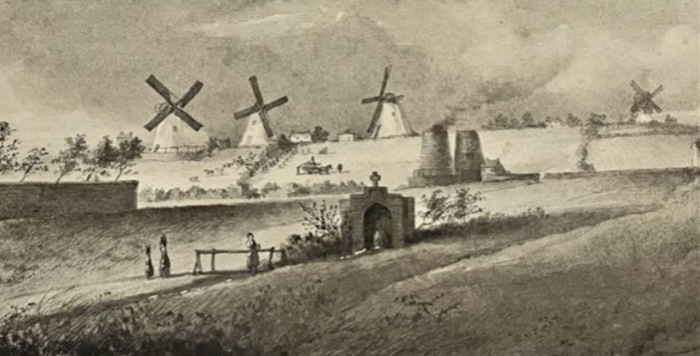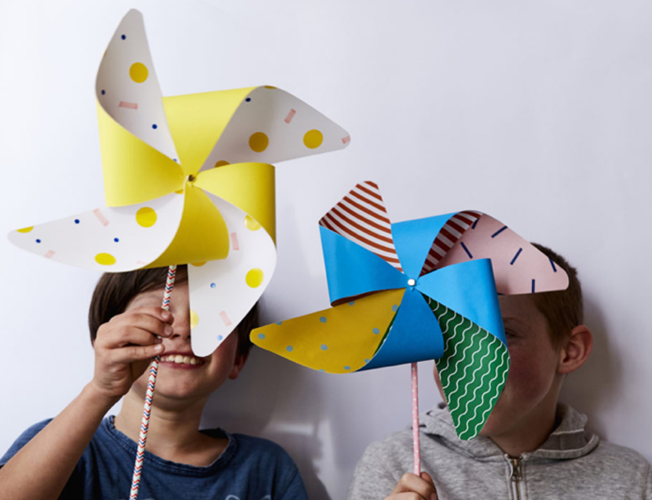Winds of Change was commissioned by St George’s Quarter CIC and has been designed by artist Simon Armstrong of Design Laser Play in collaboration with artist Laura Pullig and with support from DoES Liverpool.
It is a working windmill installation that celebrates the past, present and future of St George’s Quarter, its links to industry and the development of the city of Liverpool as a whole.
The self-sufficient windmill will have moving elements and uses some of the earliest renewable energy technology to produce its own power by harnessing the wind.
This will provide electricity for LED illumination of laser cut imagery all around the structure while also powering the modern day technological devices installed inside. The windmill will be on display in St George’s Quarter. As well as the installation, there will be a programme of creative art workshops taking place in the Library.
So why a Windmill? William Brown Street was originally known as Shaw’s Brow, an area of Liverpool growing with industry, including potteries and also the site of a windmill. This inspired St Georges CIC with to recreate the windmill and return it to William Brown Street.
Shaw’s Brow was also a major centre for pottery in Liverpool with numerous kilns visible in the area and producing at the time the popular ceramics of English Delftware (the distinctive blue and white pottery originally produced in the Netherlands). The collection of Liverpool Delftware held at the Walker Art Gallery provided inspiration, leading to a concept for the design and the technical aspects for wind generated power to provide LED illumination.
Background and History Behind the Winds of Change Concept
William Brown Street was originally called Shaw’s Brow which rose upwards into what we now know as London Road. This was one of the main centres for pottery making in the city and windmills pumped the water necessary for production. Windmills and other lined the street as it rose uphill, perfect for harnessing the wind. In the early 1700’s one of these windmills was situated at the top of Shaw’s Brow/bottom of London Road. Interestingly, Mill Street still runs between Central Library and the Walker Art Gallery and the 1950’s rebuild of the Brown Library after heavy bombing of World War II uncovered a kiln that still exists under the foundations of Liverpool Central Library.
The Artists
The instillation has been designed Simon Armstrong of Design Laser Play, and Laura Pullig with support form DoES Liverpool and is built in the workshop of Liverpool’s Royal Court.
Simon Armstrong is a graphic artist / designer. His work spans the fields of art / design / site-specific commissions, digital fabrication and production. Simon’s work is playful, engaging and sometimes uses technology to create engagement and participation. Collaboration with other practitioners allows him to investigate and explore different ways to create new work, the sharing of skills, knowledge and creativity.
Laura Pullig is a visual artist working with new media and electronics. Her work-studies how we can use technology to re-enchant people with nature and visualise the interactions of living systems. Using digital and analogue technologies she makes work that interacts with people and the environment.
Laura works with people running workshops and projects that use technology to engage people with science and nature. She specialises in techniques such as paper electronics and e-textiles to make interactive artworks with people.
DoES Liverpool is an independent maker-space, co-working space, education space and events space founded in 2011.
Friendly and open to all, DoES attracts professionals, hobbyists, students and young people with weekly public events, hot-desking, permanent desks and workshop access.
DoES Liverpool is also a self-funded community interest company, with all profits invested back into the community and making the space more epic.
Winds of Change Workshop Programme
Running alongside the instillation there are a series of free to access workshops and events for people of all ages taking place throughout St. George’s Quarter. These include:
Windmill Making Workshops – 2, 16 & 27 July, 10am to 4pm
To compliment the Winds of Change installation outside the Walker Art Gallery and St Georges Hall’s Liverpool’s Central Library is hosting Windmill Workshops throughout July. The workshops are led by the Winds of Change designer Simon Armstrong, they are drop in make & take for children of all ages. The Windmills are free to make, educational and eye-catching, and they allow friends and families to work together and take their creations home.
The Winds of Change Windmill Workshop are aimed at bringing a fun, interactive family friendly element to Central Library, with the first session being on the launch date of Winds of Change and as part of MakeFest.
Walking Tours from Arts Groupie – 2 July, 3 & 20 August, 11am and 3pm
Join John Maguire from ArtsGroupie CIC for a heritage walk around William Brown Street, formerly known as Shaws Brow, St Johns Gardens and St Georges Hall. We will explore the rich history of the area, including the Mills that helped grind the grain into flour for bread making and the renowned cultural assets in St Georges Quarter. Meet at the windmill at 11am or 3pm. For more details go to www.artsgroupie.org
Walker Art Gallery Craft and Create, 5 & 12 August, 1-4pm
Spend time together getting creative, making memories and something amazing! We have been inspired by the amazing Winds of Change installation on William Brown street this summer for our creative make and take sessions. Join us on 5 August to make your own mini windmill and on 12 August we’ll be using model magic to create little versions of the pottery that can be found in our collections.
Walker Art Gallery Winds of Change Trail
The Walker Art Gallery has lots of pottery that was made in Liverpool and even here on William Brown Street. Pop along to the gallery and pick up a trail from the desk to help you search our Gallery for the delftware pottery.
World Museum Winds of Change Display
Take a closer look at some of the pottery that was made in Liverpool with the help of the windmills which used to stand on William Brown Street. Did you know there was a distinctive colour palette used in Liverpool to decorate pottery, known as Fazakerley.
Event Date: Saturday 2nd July 2022 - Monday 29th August 2022
Location: St George's Quarter, Liverpool
Categories: Accessible event | Arts | Family | Free | Liverpool | Music




